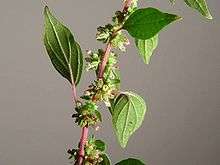Urticaceae
| Nettle family | |
|---|---|
.jpg) | |
| Urtica dioica (stinging nettle) | |
| Scientific classification | |
| Kingdom: | Plantae |
| (unranked): | Angiosperms |
| (unranked): | Eudicots |
| (unranked): | Rosids |
| Order: | Rosales |
| Family: | Urticaceae Juss., 1789 |
| Synonyms | |
|
Cecropiaceae C. C. Berg[1] | |
The Urticaceae /ɜːrtᵻˈkeɪsiː/ are a family, the nettle family, of flowering plants. The family name comes from the genus Urtica. The Urticaceae include a number of well-known and useful plants, including the nettles, ramie (Boehmeria nivea), māmaki (Pipturus albidus), and ajlai (Debregeasia saeneb).
The family includes about 2625 species, grouped into 53 genera according to the database of the Royal Botanic Gardens, Kew and Christenhusz and Byng (2016).[2] The largest genera are Pilea (500 to 715 species), Elatostema (300 species), Urtica (80 species), and Cecropia (75 species).
Urticaceae species can be found worldwide, apart from the polar regions.
Description
Urticaceae species can be shrubs (e.g. Pilea), lianas, herbs (e.g. Urtica, Parietaria), or, rarely, trees (Dendrocnide, Cecropia). Their leaves are usually entire and bear stipules. Urticating (stinging) hairs are often present. They have usually unisexual flowers and can be both monoecious or dioecious. They are wind-pollinated. Most disperse their pollen when the stamens are mature and their filaments straighten explosively, a peculiar and conspicuously specialised mechanism.
Taxonomy

The APG II system puts the Urticaceae in the order Rosales, while older systems consider them part of the Urticales, along with Ulmaceae, Moraceae, and Cannabaceae. APG still considers "old" Urticales a monophyletic group, but does not recognise it as an order on its own.
Genera (partial list)
|
|
|
Diseases
The Urticaceae are subject to many bacterial, viral, fungal, and nematode parasitic diseases. Among them are:[4]
- Bacterial leaf spot, caused by Xanthomonas campestris which affects Pellionia, Pilea, and other genera
- Anthracnose, a fungal disease caused by Colletotrichum capsici which affects Pilea
- Myrothecium leaf spot, a fungal disease caused by Myrothecium roridum which affects plants throughout the Urticaceae, as well as other angiosperms[5][6]
- Phytophthora blight, a water mold disease caused by Phytophthora nicotianae which affects Pilea
- Southern blight, a fungal disease caused by Athelia rolfsii which affects both Pellionia and Pilea
Image gallery
 Pilea cadierei
Pilea cadierei- Pilea pumila
 Dendrocnide sp.
Dendrocnide sp. Elatostema umbellatum
Elatostema umbellatum- Urtica dioica
 Boehmeria nivea
Boehmeria nivea Parietaria judaica flowers
Parietaria judaica flowers Urtica dioica stinging hairs
Urtica dioica stinging hairs
References
| Wikimedia Commons has media related to Urticaceae. |
- ↑ Germplasm Resources Information Network (GRIN) (2003-01-17). "Family: Urticaceae Juss., nom. cons.". Taxonomy for Plants. USDA, ARS, National Genetic Resources Program, National Germplasm Resources Laboratory, Beltsville, Maryland. Retrieved 2008-04-24.
- ↑ Christenhusz, M. J. M., and Byng, J. W. (2016). "The number of known plants species in the world and its annual increase". Phytotaxa. Magnolia Press. 261 (3): 201–217. doi:10.11646/phytotaxa.261.3.1.
- ↑ "Metatrophis F. Br.". Germplasm Resources Information Network. United States Department of Agriculture. 2009-01-16. Retrieved 2009-03-11.
- ↑ "Common Names of Plant Diseases: Diseases of Foliage Plants (House Plants): Urticaceae". The American Phytopathological Society. 26 March 1993. Archived from the original on 30 November 2011.
- ↑ Chase, A. R. (1983). "Influence of host plant and isolate source on Myrothecium leaf spot of foliage plants" (PDF). Plant Disease. 67 (6): 668–671. doi:10.1094/PD-67-668.
- ↑ Nguyen, Thu Ha, Mathur, S. B., & Neergaard, Paul (1973). "Seed-borne species of Myrothecium and their pathogenic potential". Transactions of the British Mycological Society. 61 (2): 347–354, IN14–IN16. doi:10.1016/S0007-1536(73)80156-1.
Further reading
- Pignatti, Sandro (1982). Flora d'Italia (in Italian). Bologna: Edagricole. ISBN 88-506-2449-2.
- Friis, Ib (1989). Urticaceae. Flora of tropical East Africa. Rotterdam: A.A. Balkema and the Royal Botanic Gardens, Kew. ISBN 978-90-6191-352-8.
External links
- Stevens, P. F. "Angiosperm Phylogeny Website, Version 13". Missouri Botanical Garden. continuously updated.